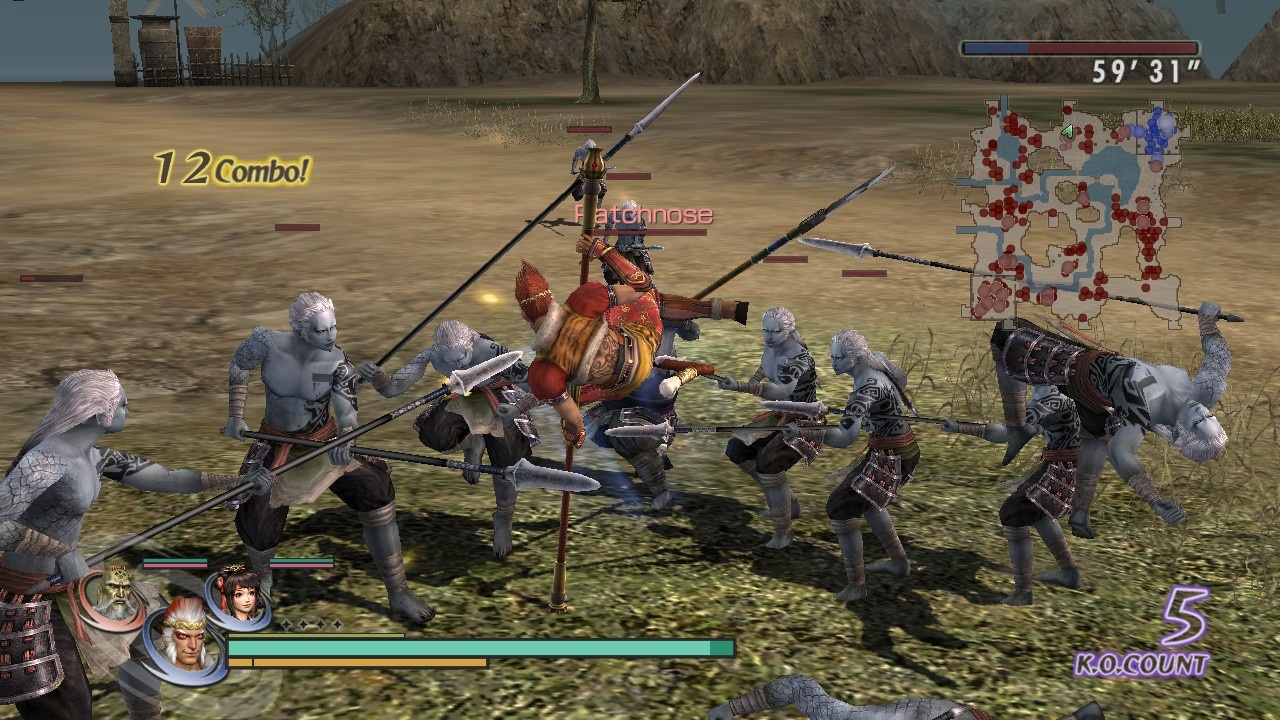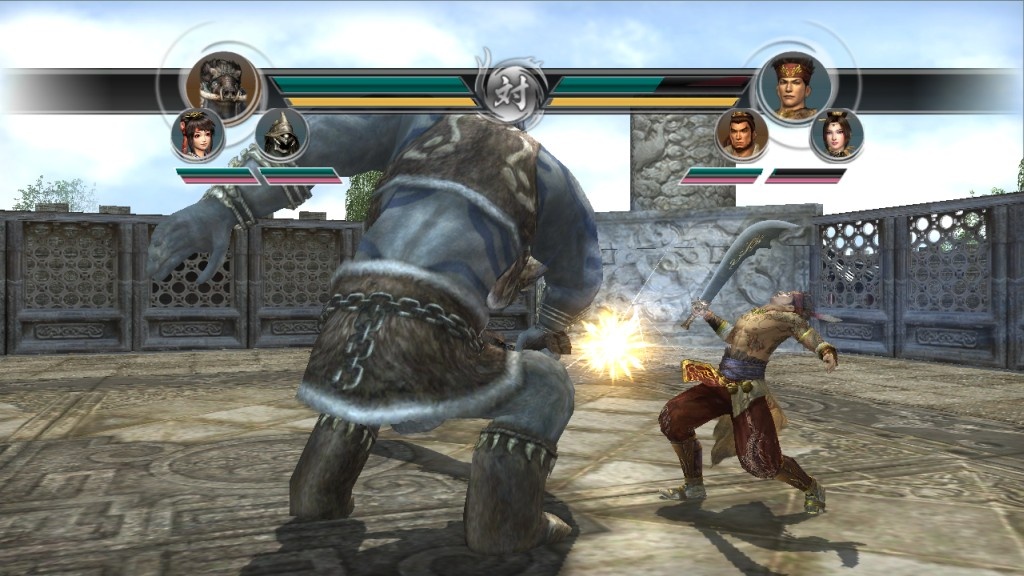Since the release of Dynasty Warriors 2 in 2000, Koei has churned out a remarkable number of games in its Dynasty Warriors and Samurai Warriors series of hack-and-slash action games. Yet over the years, for all these sequels, the gameplay has hardly evolved at all. A year ago, Warriors Orochi brought these two series together, but aside from its unusual crossover concept, it did nothing to differentiate itself from its predecessors. Now, Warriors Orochi 2 is here, and it continues the trend of delivering all the excruciatingly repetitive gameplay, as well as lack of innovation, for which the series has become known.
In Warriors Orochi, the titular serpent king decides to merge third-century China with 16th-century Japan, conveniently uniting characters from the Dynasty Warriors and Samurai Warriors games. The brave heroes ultimately put aside their cultural and temporal differences to thwart Orochi's plans to conquer this strange new world. But it's not long before violence and unrest again befall the land. There are a total of five stories to select from in Orochi 2's Story mode: one for each of the three kingdoms of China, one for the Samurai Warriors of Japan, and one about Orochi along with his followers, which serves as a prequel to the first game. Each story is equally awful. The use of static character portraits is lame while the dialogue is clumsy and full of awkward anachronisms like "Breaking news!" The voice acting is also appalling. The narrator sounds like he's reading the news on NPR, and the broad characterizations of the warriors, who sound like pompous aristocrats, dumb oafs, or valley girls, don't endear the characters to you one bit. On the contrary, just spending time in their company is unpleasant.

The action takes place on large battlefields. You choose three characters to take into battle, and you can switch among them at any time. The concept of fighting in the midst of a raging battle as armies clash around you sounds ripe with potential, but Warriors Orochi 2 utterly fails to deliver on it. Rather than viciously attacking each other, enemy soldiers seem to be trained to run up to you and wait calmly for you to kill them, giving you the occasional gentle poke with their spears or swords to nudge you on. In addition to being identically stupid, all the soldiers in any given unit look the same, which may have been forgivable at one time, but now makes the series look as dated as it feels.
As you hack your way through your enemies, there's no sense of impact or resistance. Your weapon seems to just go right through them. You'll lay waste to several-hundred enemy soldiers in a typical battle, just by pressing the attack button over and over again. This is about as dull as hack-and-slack action gets. To be fair, you have a modest variety of attacks you can employ, and there are three basic types of heroes, each with his own unique abilities. There's also a new type of attack--the triple attack--in which all three members of your team attack the enemy at once. But in practice, this variety doesn't matter much. The enemy soldiers go down very easily, regardless of how you choose to dispatch them, and using the occasional special attack doesn't make it any more interesting.
A bigger threat than the enemy is the ineptitude of your own allies. Each scenario has conditions for victory and for defeat. Victory generally comes when you kill certain enemy captains, while defeat is typically the result of losing a captain on your side. Throughout each battle, you'll constantly be updated on events taking place all over the battlefield, and if you see that a crucial captain of yours is being attacked, you'll want to rush to his aid immediately because captains can't hold their own against the enemy for very long. Having to babysit your allies only makes the action that much more tiresome.
You earn experience during each battle, which makes your characters stronger. In between battles you can fuse your acquired weapons together into more powerful ones, as well as equip your characters with a range of special abilities, such as stronger defense or a gradually refilling life gauge. But all this growth and development is hard to get invested in when the action it serves is so tedious. At least leveling up means you can cut through your foes faster, and anything that makes the game go by faster is a good thing.
In addition to the game's Story mode, there's a Free mode, in which you can play any unlocked scenario with any character. There's also a Dream mode, which features a number of scenarios that fall outside of the main storylines. Those with a deep knowledge of the history and lore of the characters may get a kick out of seeing Yoshimoto Imagawa, Xing Cai, and Ginchiyo Tachibana fight alongside each other, but for most of us, there's nothing that sets these levels apart from those you encounter during the Story mode.
Playing the game cooperatively with a friend makes it a bit more bearable only because then you have someone to commiserate with about how boring it is, though the split-screen makes the already cruddy graphics even less impressive. There are also a few competitive modes available, including Tag Team and Elimination modes. These play out like a typical fighting game, and because your human opponent is invariably more intelligent than what the game throws at you, they're some of the more interesting offerings here. But they don't come close to offering the depth and intensity of most dedicated fighting games, so even this won't hold your interest for long. There's also a game mode called Tower, in which the object is to knock more brain-dead enemies off of a tower rooftop than your opponent, and one called Steeplechase. This last mode, a race on horseback, has items you can pick up and use much like in a typical cart racer. However, you're limited to just one uninspired track, and the horses control so loosely that just getting them to go where you want is a challenge. There's no online support for these or any of the game's modes, but considering how poor they all are, that's really no big loss.

The graphics are very disappointing. Aside from being considerably sharper than the PS2 version, the 360 version doesn't look significantly better. In both versions, the environments are bland and lacking in detail. The visual glitches, such as fences popping into and out of existence, are also commonplace. The sound is even more dreadful than the visuals. The voice acting is heinous, the sounds of battle are lifeless, the music is forgettable, and you'll hear characters constantly repeat the same few obnoxious phrases.
At least the first Warriors Orochi game had the novelty of the crossover concept, which was a clever bit of fan service. By now, that novelty has worn off. With each subsequent iteration of the Warriors series, the gameplay feels increasingly tired. Warriors Orochi 2 has a whopping 92 playable characters, which is 13 more warriors than in the last game, but just tossing more characters into the mix does nothing to correct the fundamental problems with the series.